- IAS Preparation
- UPSC Preparation Strategy
- Pmmy Pradhan Mantri Mudra Yojana

Pradhan Mantri Mudra Yojana (PMMY) - Indian Polity
To enable every last mile financer to lend credit to all types of businesses in the country, the MUDRA- Micro Units Development and Refinance Agency bank was established as a public sector financial institution. Low rate loans are provided by micro financers under this scheme.
This Government scheme is an important topic for the IAS Exam . Subjects related to this topic are Indian Polity and Social Justice from General Studies paper 2 as well as Indian Economy from general Studies paper 3 of the UPSC Syllabus .
Pradhan Mantri Mudra Yojana
Launched in April 2015 by the Prime Minister, the Mudra Yojana aims to enable Micro Finance Institutions (MFIs), Non-Banking financial institutions/Companies (NBFCs), Small Finance Banks, RBRs, Commercial Banks, Cooperative Banks, etc. to provide low interest rate on personal loans to eligible entities.

Candidates can know the detailed information about the Pradhan Mantri Mudra Yojana on the Official Website .
PMMY Eligibility
To avail of the benefits of the PMMY Scheme, the person should be a citizen of India . The loans are basically for people having a business plan in a Non-Farming Sector with Income generating activities like the following:
- Manufacturing
- Service Sector
- Or any other fields whose credit demand is less than ₹10 lakhs .
The Indian Citizen seeking MUDRA Loans under the PMMY Scheme will have to approach either an MFI, Bank or NBFC to avail it.
Objectives of Pradhan Mantri Mudra Yojana –
- Funding the unfunded – To sanction loans up to rupees 10 Lakhs to those who have a business plan to generate income from a non-farm activity like manufacturing, processing, trading, or service sector but don’t have enough capital to invest
- Reducing jobless economic growth – To help generate sources of employment and increase the overall GDP by providing micro-enterprises with credit facilities.
- Monitoring and regulating the Microfinance institutions (MFI) – With the help of MUDRA bank, the network of microfinance institutions will be monitored and new registration will also be done.
- Integration of Informal economy into Formal sector – It will help India also grow its tax base as incomes from the informal sector are non-taxed.
- Promoting financial inclusion – PMMY further adds to the vision of financial inclusion with the aim to reach the last mile credit delivery to micro-businesses and taking the help of technology solutions.
Types of PMMY Loans
The Pradhan Mantri Mudra Yojana (PMMY) has three products as per the funding requirements of the Beneficiary or the Entrepreneur.
Sectors Covered under PMMY
To maximize coverage of beneficiaries and tailor products to meet requirements of specific business activities, sector/activity focused schemes would be rolled out. To begin with, based on the higher concentration of businesses in certain activities/sectors, schemes are proposed for:
Pradhan Mantri Mudra Yojana (PMMY):- Download PDF Here
Related Links:
Leave a Comment Cancel reply
Your Mobile number and Email id will not be published. Required fields are marked *
Request OTP on Voice Call
Post My Comment
IAS 2024 - Your dream can come true!
Download the ultimate guide to upsc cse preparation.
- Share Share

Register with BYJU'S & Download Free PDFs
Register with byju's & watch live videos.
PTE EXAM PREPARATION
PTE Academic Exam Practice Material
MUDRA Yojana Essay
Write Pradhan Mantri Mudra Yojana essay in English. Prepare Mudra Yojana essay for competitive exams and English test in schools and colleges. Essay on Mudra Yojana in English in 300 words.
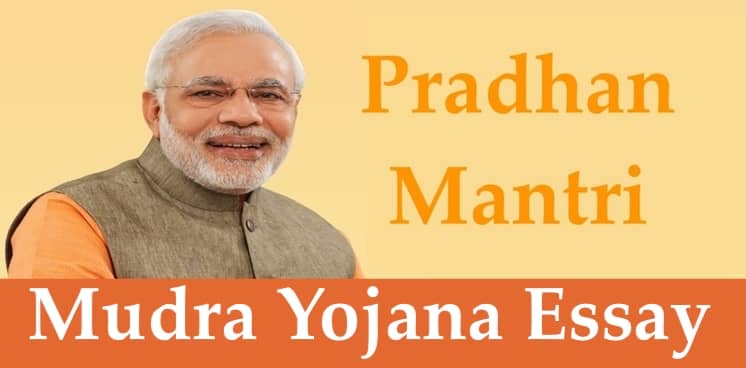
Mudra Yojana Essay in English
On 8th April 2015, Prime Minister Narendra Modi launched this Micro unit development and refinance agency (MUDRA) scheme in order to uplift a small business and entrepreneurs of MSME (Micro Small Medium Enterprises). Under the scheme, Mudra Bank will establish which provide Loan at low rates to a microfinance institution (MFI) which then provide credit to (MSME).
The main objective of this mission is to provide loans up to 10 lakh to micro enterprises, which were 5.77 crores in number (NSSO survey 2013). These loans are given by the commercial bank, RRBs, small finance banks, cooperative banks, MFIs and non-banking financial company (NBFCs). Under this Yojana, three types of loan are sanctioned that is Shishu (up to 50,000), Kishore (above 50,000 and up to Rs 5,00,000), Tarun (Above 5 lakh and up to 10 lakh). Mudra bank is also responsible for providing policy guidelines, registration Regulation and Technology Solutions for the problem faced by MFI.
Major advantages of this scheme is that it is a great tool for job creation as 5.5 crore jobs were created by PMMY, development of the economy, industrialisation of rural areas, reduces regional imbalance and ensure equitable distribution of national income.
Some challenges come in the way of Mudra scheme such as low financial literacy, fraudulent loans, delay in processing, lack of market development, poor grievance redressal and Bank NPA.
PMMY is definitely a potent step towards the development of the economy, enhancing income generation in the country. Due to eating there is a Revolutionary change in the area of micro finance. This scheme will help the weaker section, low-income group and unfunded population.
More Essay Topics
Farmer Suicide in India Essay Food Security in India Essay Essay on Right to Information Ayushman Bharat Essay Essay on Newspaper Unemployment Problem in India Essay
General Studies
All Programmes
Study Material
Pradhan Mantri Mudra Yojana (PMMY)

The Union Finance and Corporate Affairs Minister recently said women entrepreneurs are accorded first priority under the Centre's flagship Pradhan Mantri Mudra Yojana scheme.
About pradhan mantri mudra yojana (pmmy).
- It is a flagship scheme of the Government of India to extend affordable credit to micro and small enterprises.
- Mudra schemes are designed to bring enterprises into the formal financial system or to “fund the unfunded”.
- It enables a small borrower to borrow from all Public Sector Banks such as PSU Banks, Regional Rural Banks and Cooperative Banks, Private Sector Banks, Foreign Banks, Micro Finance Institutions (MFI), and Non Banking Finance Companies (NBFC) for loans upto Rs 10 lakhs for non-farm income-generating activities.
- Eligibility: Any Indian citizen who has a business plan for a non-farm sector income generating activity such as manufacturing, processing, trading, or the service sector and whose credit need is less than Rs 10 lakh can approach either a bank, MFI, or NBFC for availing of Micro Units Development & Refinance Agency Ltd. (MUDRA) loans under PMMY.
- Shishu: covering loans upto 50,000/-
- Kisho: covering loans above 50,000/- and upto 5 lakh
- Tarun: covering loans above 5 lakh and upto 10 lakh
- There is no subsidy for the loan given under PMMY. However, if the loan proposal is linked to some Government scheme, wherein the Government is providing capital subsidies, it will be eligible under PMMY also.
Q1) What are Microfinance Institutions (MFI)?
Microfinance institutions (MFIs) are financial companies that provide small loans to people who do not have any access to banking facilities. The definition of "small loans" varies between countries. In India, all loans that are below Rs. 1 lakh can be considered as microloans.
Source: Women Accorded Top Priority Under PM Mudra Yojana Scheme: Union Minister
Download PDF
Share this article.
© 2024 Vajiram & Ravi. All rights reserved
- Bahasa Indonesia
- Slovenščina
- Science & Tech
- Russian Kitchen
Why were so many metro stations in Moscow renamed?
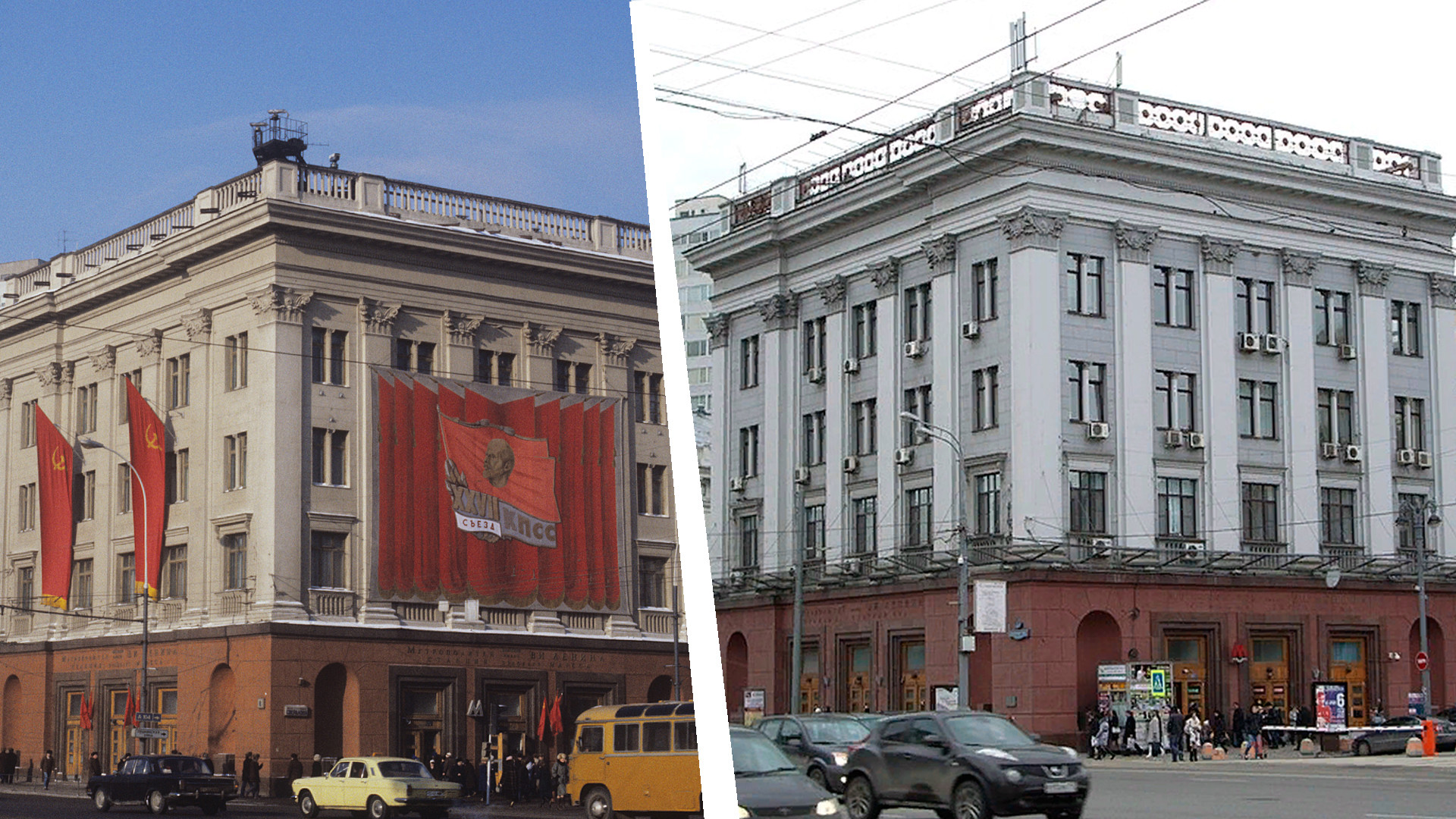
Okhotny Ryad station in Soviet times and today.
The Moscow metro system has 275 stations, and 28 of them have been renamed at some point or other—and several times in some cases. Most of these are the oldest stations, which opened in 1935.
The politics of place names
The first station to change its name was Ulitsa Kominterna (Comintern Street). The Comintern was an international communist organization that ceased to exist in 1943, and after the war Moscow authorities decided to call the street named after it something else. In 1946, the station was renamed Kalininskaya. Then for several days in 1990, the station was called Vozdvizhenka, before eventually settling on Aleksandrovsky Sad, which is what it is called today.
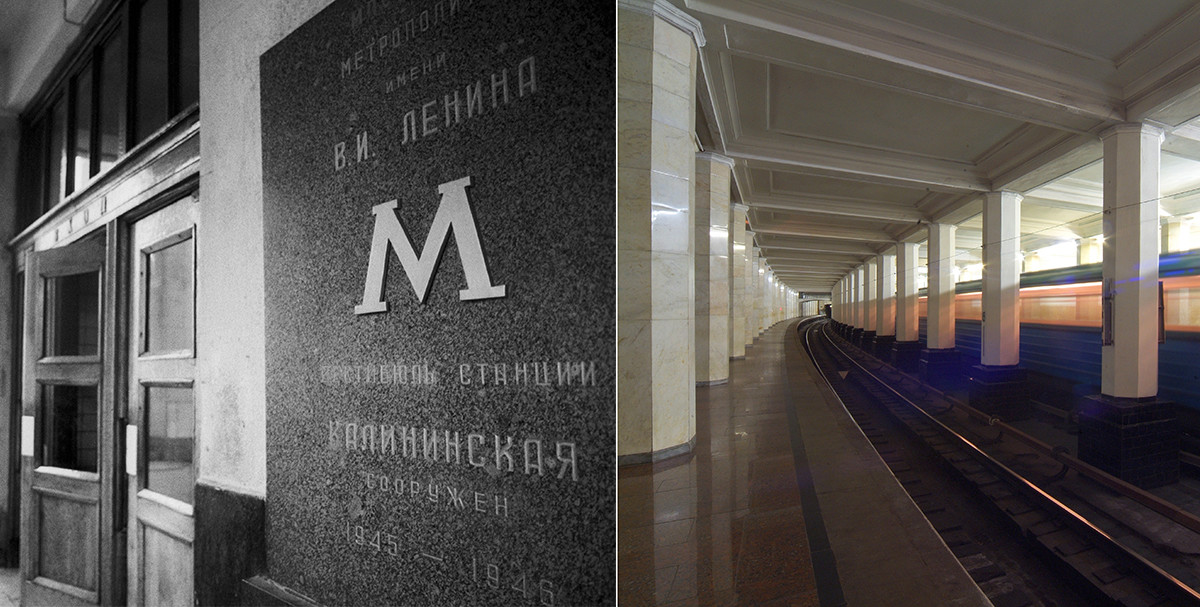
The banner on the entraince reads: "Kalininskaya station." Now it's Alexandrovsky Sad.
Until 1957, Kropotkinskaya station was called Dvorets Sovetov ( Palace of Soviets ). There were plans to build a monumental Stalinist high-rise on the site of the nearby Cathedral of Christ the Saviour , which had been demolished. However, the project never got off the ground, and after Stalin's death the station was named after Kropotkinskaya Street, which passes above it.
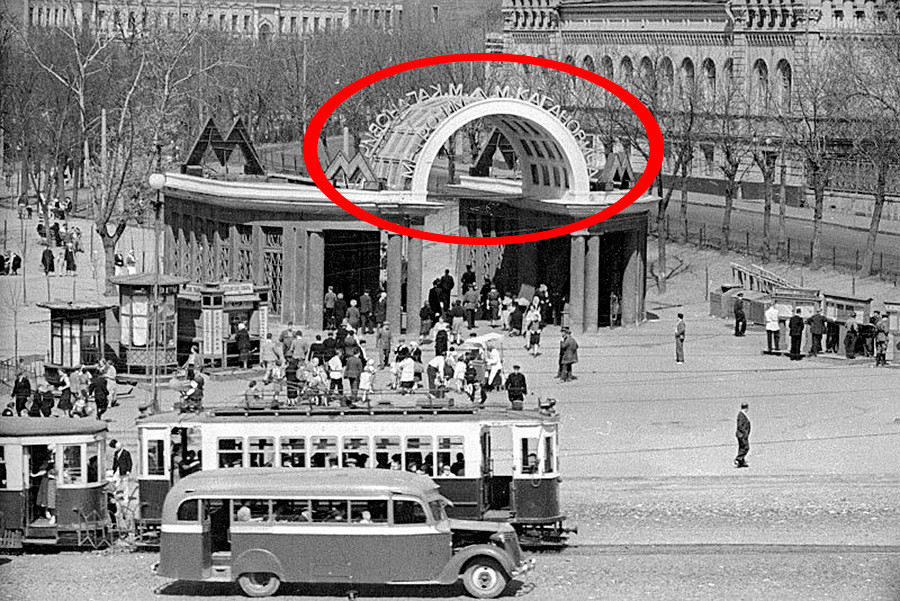
Dvorets Sovetov station, 1935. Letters on the entrance: "Metro after Kaganovich."
Of course, politics was the main reason for changing station names. Initially, the Moscow Metro itself was named after Lazar Kaganovich, Joseph Stalin’s right-hand man. Kaganovich supervised the construction of the first metro line and was in charge of drawing up a master plan for reconstructing Moscow as the "capital of the proletariat."
In 1955, under Nikita Khrushchev's rule and during the denunciation of Stalin's personality cult, the Moscow Metro was named in honor of Vladimir Lenin.
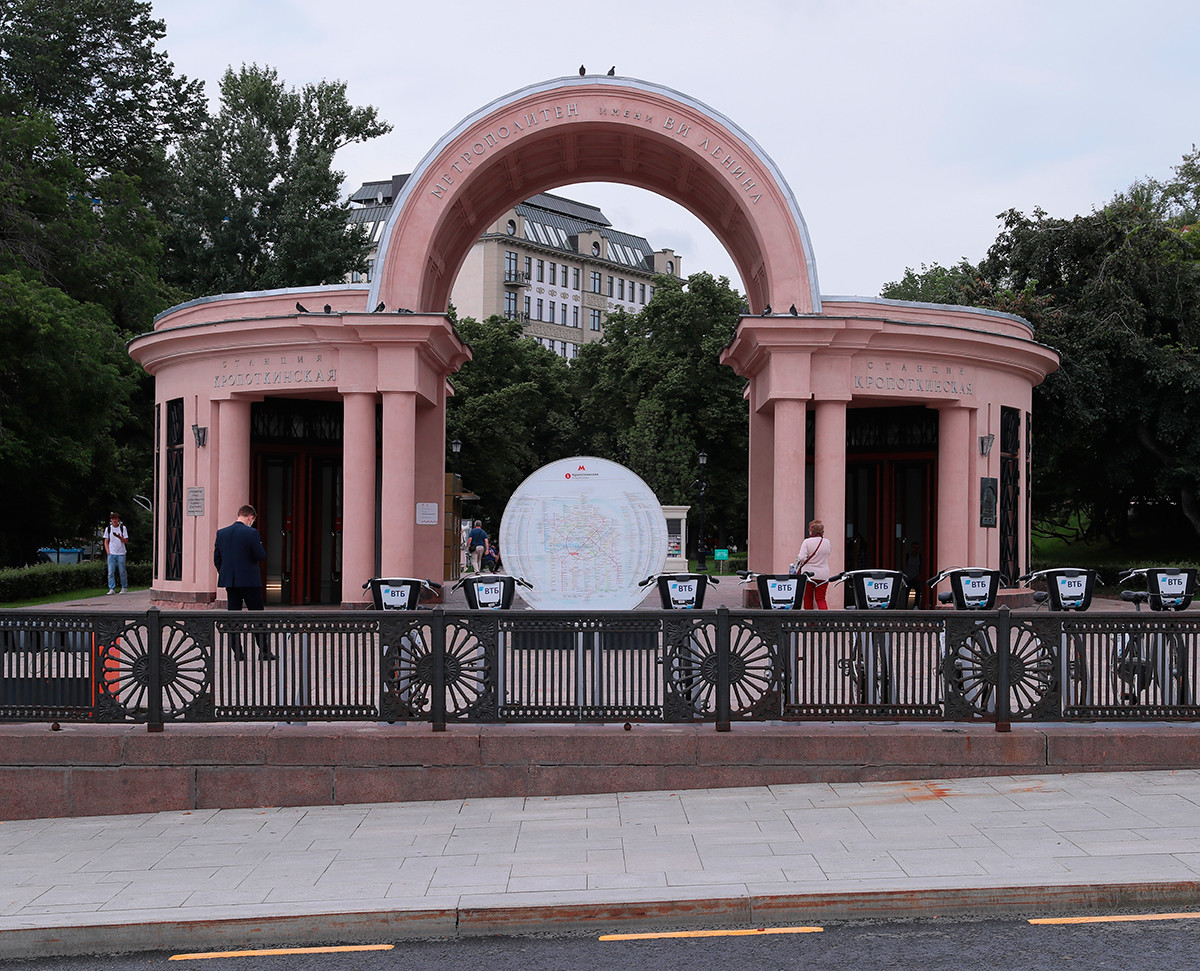
Kropotkinskaya station, our days. Letters on the entrance: "Metropolitan after Lenin."
New Metro stations that have been opened since the collapse of the Soviet Union simply say "Moscow Metro," although the metro's affiliation with Vladimir Lenin has never officially been dropped.

Zyablikovo station. On the entrance, there are no more signs that the metro is named after Lenin.
Stations that bore the names of Stalin's associates were also renamed under Khrushchev. Additionally, some stations were named after a neighborhood or street and if these underwent name changes, the stations themselves had to be renamed as well.
Until 1961 the Moscow Metro had a Stalinskaya station that was adorned by a five-meter statue of the supreme leader. It is now called Semyonovskaya station.
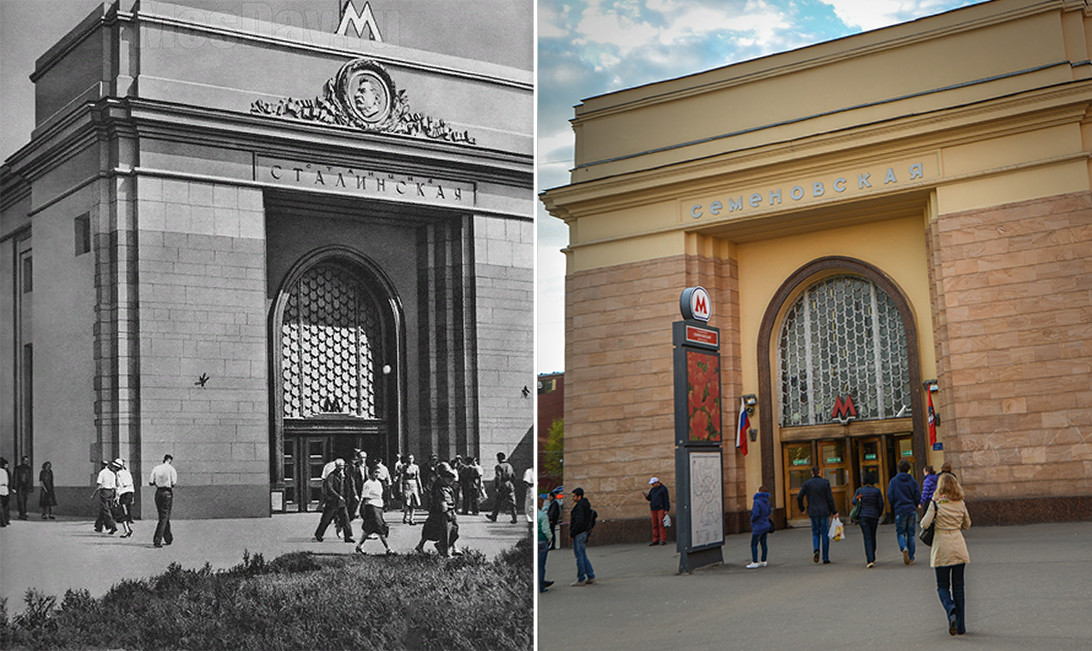
Left: Stalinskaya station. Right: Now it's Semyonovskaya.
The biggest wholesale renaming of stations took place in 1990, when Moscow’s government decided to get rid of Soviet names. Overnight, 11 metro stations named after revolutionaries were given new names. Shcherbakovskaya became Alekseyevskaya, Gorkovskaya became Tverskaya, Ploshchad Nogina became Kitay-Gorod and Kirovskaya turned into Chistye Prudy. This seriously confused passengers, to put it mildly, and some older Muscovites still call Lubyanka station Dzerzhinskaya for old times' sake.
At the same time, certain stations have held onto their Soviet names. Marksistskaya and Kropotkinskaya, for instance, although there were plans to rename them too at one point.
"I still sometimes mix up Teatralnaya and Tverskaya stations,” one Moscow resident recalls .
“Both have been renamed and both start with a ‘T.’ Vykhino still grates on the ear and, when in 1991 on the last day of my final year at school, we went to Kitay-Gorod to go on the river cruise boats, my classmates couldn’t believe that a station with that name existed."
The city government submitted a station name change for public discussion for the first time in 2015. The station in question was Voykovskaya, whose name derives from the revolutionary figure Pyotr Voykov. In the end, city residents voted against the name change, evidently not out of any affection for Voykov personally, but mainly because that was the name they were used to.
What stations changed their name most frequently?
Some stations have changed names three times. Apart from the above-mentioned Aleksandrovsky Sad (Ulitsa Kominterna->Kalininskaya->Vozdvizhenka->Aleksandrovsky Sad), a similar fate befell Partizanskaya station in the east of Moscow. Opened in 1944, it initially bore the ridiculously long name Izmaylovsky PKiO im. Stalina (Izmaylovsky Park of Culture and Rest Named After Stalin). In 1947, the station was renamed and simplified for convenience to Izmaylovskaya. Then in 1963 it was renamed yet again—this time to Izmaylovsky Park, having "donated" its previous name to the next station on the line. And in 2005 it was rechristened Partizanskaya to mark the 60th anniversary of victory in World War II.
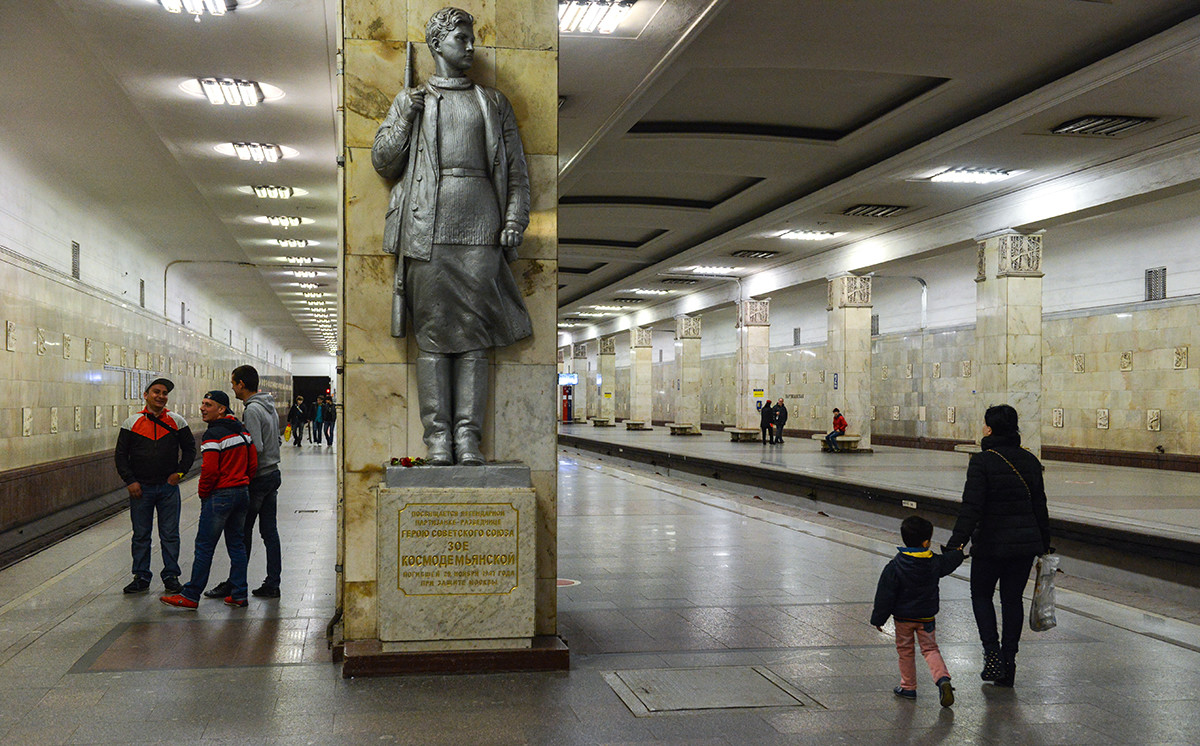
Partizanskaya metro station, nowadays.
Another interesting story involves Alekseyevskaya metro station. This name was originally proposed for the station, which opened in 1958, since a village with this name had been located here. It was then decided to call the station Shcherbakovskaya in honor of Aleksandr Shcherbakov, a politician who had been an associate of Stalin. Nikita Khrushchev had strained relations with Shcherbakov, however, and when he got word of it literally a few days before the station opening the builders had to hastily change all the signs. It ended up with the concise and politically correct name of Mir (Peace).
The name Shcherbakovskaya was restored in 1966 after Khrushchev's fall from power. It then became Alekseyevskaya in 1990.
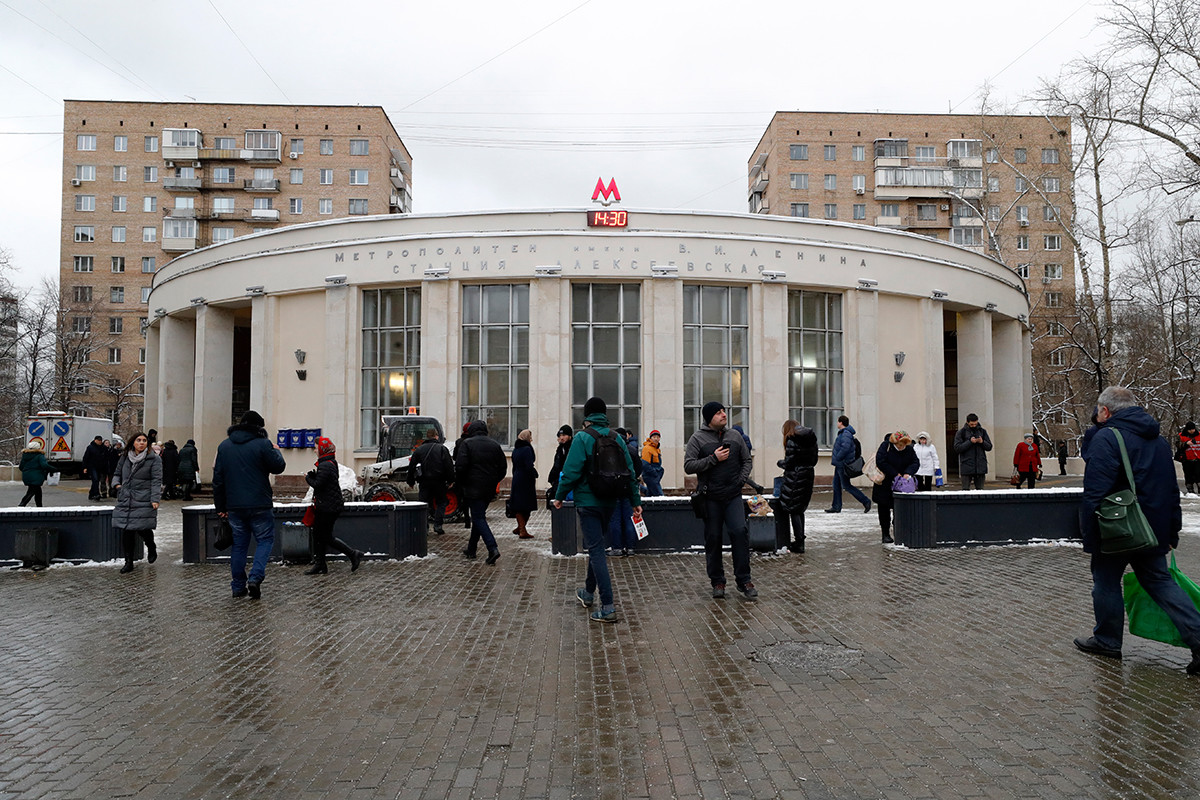
Alekseyevskaya metro station.
But the station that holds the record for the most name changes is Okhotny Ryad, which opened in 1935 on the site of a cluster of market shops. When the metro system was renamed in honor of Lenin in 1955, this station was renamed after Kaganovich by way of compensation. The name lasted just two years though because in 1957 Kaganovich fell out of favor with Khrushchev, and the previous name was returned. But in 1961 it was rechristened yet again, this time in honor of Prospekt Marksa, which had just been built nearby.
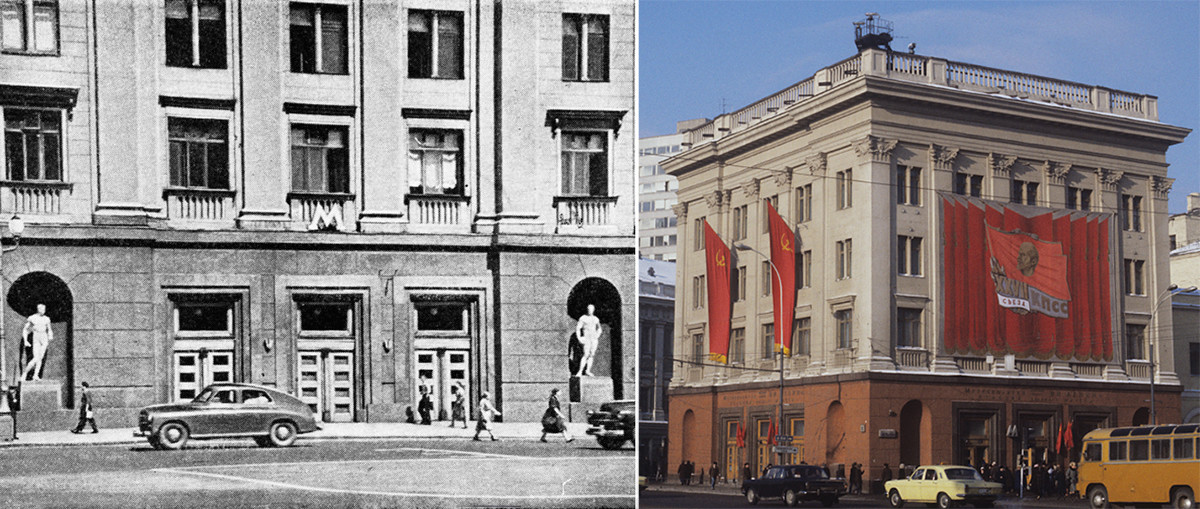
Okhotny Ryad station in 1954 and Prospekt Marksa in 1986.
In 1990, two historical street names—Teatralny Proyezd and Mokhovaya Street—were revived to replace Prospekt Marksa, and the station once again became Okhotny Ryad.
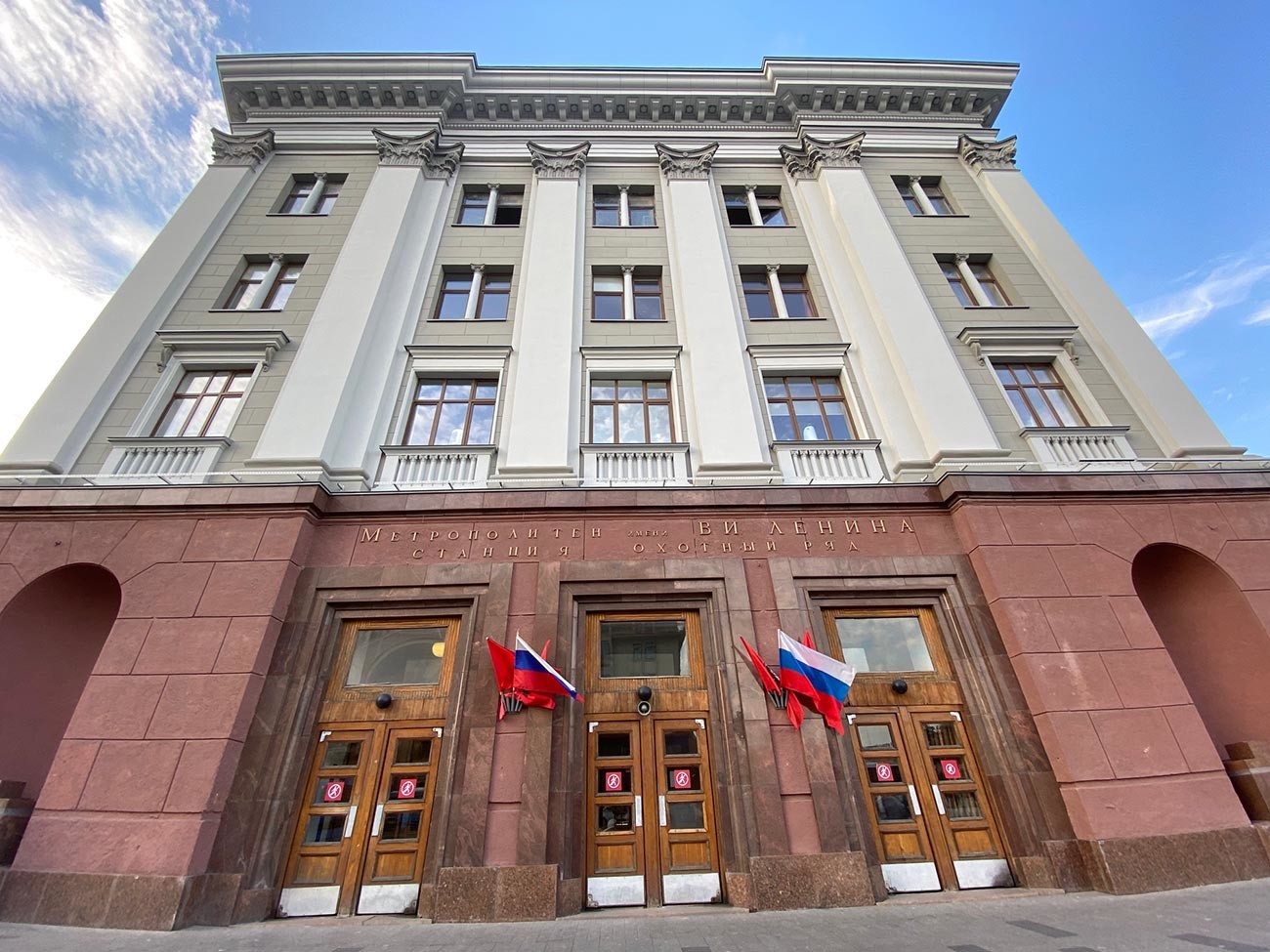
Okhotny Ryad in 2020.
If using any of Russia Beyond's content, partly or in full, always provide an active hyperlink to the original material.
to our newsletter!
Get the week's best stories straight to your inbox
- 7 things that the USSR unexpectedly put on WHEELS
- Why did the USSR build subway stations inside residential buildings? (PHOTOS)
- How Russian trains deal with winter
This website uses cookies. Click here to find out more.

IMAGES
VIDEO
COMMENTS
Mudra Yojana Essay: ... According to the project, the Mudra Bank will provide low rates loan to a microfinance institution (MFI) which in turn will offer the credit to MSME. The primary mission of this scheme is to deliver loans up to ten lakhs to micro-enterprises which by the performed by NSSO in 2013 were 5.77 crores in number. Small finance ...
Pradhan Mantri Mudra Yojana (PMMY) - Indian Polity. To enable every last mile financer to lend credit to all types of businesses in the country, the MUDRA- Micro Units Development and Refinance Agency bank was established as a public sector financial institution. Low rate loans are provided by micro financers under this scheme.
Microfinance and refinance. Micro Units Development and Refinance Agency Bank (or MUDRA Bank) [1]) is a public sector financial institution in India. It provides loans at low rates to micro-finance institutions and non-banking financial institutions which then provide credit to MSMEs. It was launched by Prime Minister Narendra Modi on 8 April 2015.
class via Micro Units Development and Refinance Agency (MUDRA) Bank. The PM Mudra Yojana (PMMY) is a positive effort to fulfill the credit needs of the micro businesses and self-employed individuals, the majority of whom are in the informal sector and thereby address the biggest obstacle to their socio-economic growth. ...
MUDRA Yojana Essay. On 8th April 2015, Prime Minister Narendra Modi launched this Micro unit development and refinance agency (MUDRA) scheme in order to uplift a small business and entrepreneurs of MSME (Micro Small Medium Enterprises). Under the scheme, Mudra Bank will establish which provide Loan at low rates to a microfinance institution ...
Benefits of Mudra Yojana. This government scheme offers a multitude of benefits: Access to finance for businesses that lack collateral. Competitive interest rates to ensure affordability. Flexible ...
PDF | The Pradhan Mantri Mudra Yojana, launched in 2015, grants collateral-free loans to the unfunded by collaborating with the financial institutions.... | Find, read and cite all the research ...
This paper is to know about the MUDRA Yojana and its key objectives. The paper highlights the importance and the role of MUDRA bank towards the small business units. Keywords: MUDRA,PMMY,MSME,MICRO FINANCE I. Introduction By The Startup of MUDRA and Pradhan Mantri Mudra Yojana (PMMY) by the Honorable Prime Minister on April 08, 2015.
About Pradhan Mantri Mudra Yojana (PMMY) It is a flagship scheme of the Government of India to extend affordable credit to micro and small enterprises. Mudra schemes are designed to bring enterprises into the formal financial system or to "fund the unfunded". It enables a small borrower to borrow from all Public Sector Banks such as PSU ...
A Case Study on the Impacts of the Pradhan Mantri. Mudra Yojana on the Banking Sector in India. Shashank B. S. 1 * & Sureshramana Mayya 2. 1 Research Scholar, Institute of Management and Commerce ...
Venkatesh (2015) analyzed the role of MUDRA bank in the development of MSMEs and found that PMMY was playing a vital role in the development of the small and micro sectors in India. Mudra Bank helped in boosting the growth of the MSME sector and this will help in increasing the GDP of India from the current level which is 38 percent.
Mudra Yojana of the Total Banks NPA is approximately 3-4% and under the MUDRA category the Shishu loan showing higher NPA Because of low business knowledge and skills at initial stage of business. Keywords: GNPA, MSMEs Performance, Mudra Bank, NNPA, NPA, PMMY. 1. Introduction: MSMEs are becoming India's main source of economic growth.
Related Resources. Pradhan Mantri Mudra Yojana (PMMY) is a flagship scheme of Government of India to "fund the unfunded" by bringing such enterprises to the formal financial system and extending affordable credit to them. It enables a small borrower to borrow from all Public Sector Banks such as PSU Banks, Regional Rural Banks and ...
The setting up of Pradhan Mantri Mudra Yojana and MUDRA attempted to fill or reduce the financial crisis in the micro enterprises to stimulate economic development. MUDRA has been aimed at administering a common platform to both banks and tiny enterprises customers and plays a significant role by bringing them together to this platform. It has been set up as a refinancing institution. Its main ...
Why in News. More than 28.68 crore loans for an amount of Rs. 14.96 lakh crore have been sanctioned by banks, NBFCs and MFIs since the launch of Pradhan Mantri Mudra Yojana (PMMY).. Key Points. About Pradhan Mantri Mudra Yojana (PMMY): Launch and Aim: It was launched by the government in 2015 for providing loans up to Rs. 10 lakh to the non-corporate, non-farm small/micro-enterprises.
launched MUDRA Yojana to address the financial and other constraints. This paper is an attempt to know about the MUDRA Yojana and its key objectives. The paper highlights the importance and the role of MUDRA bank towards the small business units. Key Words:- Small Business Units, MUDRA, MFIs, MSME, last mile lending. ...
The Government of India is trying to make India job provider, not a job seeker. In this direction, several policies have been launched by the government of India starting from Pradhan Mantri Mudra ...
The challenges which came in the way of Mudra were problems like fraudulent loans, low financial literacy, lack of market development, Bank NPA, delay in processing and poor grievance redressal. Mudra Yojana is a practical step towards the development of the country's economy and in enhancing the income generation in the country.
Mudra Bank Loan Yojna or Pradhanmantri Mudra Yojna is a Business loan scheme tailored specifically for small scale businesses. Here, Mudra stands for Micro Unit development and Refinance Agency. The scheme was launched on 8th April 2015 to provide support to small business owners in the country. The scheme operates in three stages- Shishu ...
Nearly one-third of Russia's 2024 budget was allocated towards defense spending. Social expenditures, covering salaries, pensions, and benefits, constituted only about one-fifth of the budget. Russia's economy does not create much that is in demand. Its manufacturing sector is small, and its business sector is non-existent.
In 1954, Elemash began to produce fuel assemblies, including for the first nuclear power plant in the world, located in Obninsk. In 1959, the facility produced the fuel for the Soviet Union's first icebreaker. Its fuel assembly production became serial in 1965 and automated in 1982. 1. Today, Elemash is one of the largest TVEL nuclear fuel ...
A visit to Russia is my to-do list. Great people & culture. [ Reply To This Message ] [ Share Thread on Facebook ] [ Start a New Thread ] [ Back to Thread List ]
The Moscow metro system has 275 stations, and 28 of them have been renamed at some point or other—and several times in some cases. Most of these are the oldest stations, which opened in 1935.